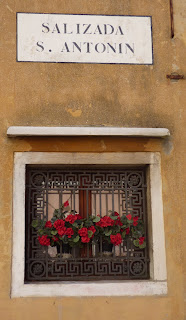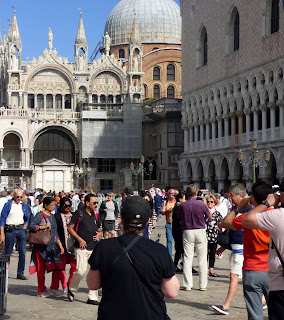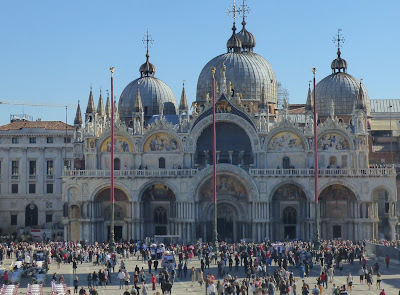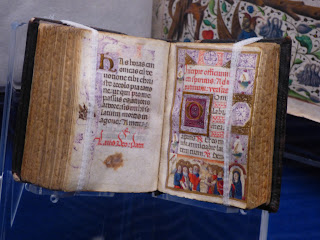VERONA
The fast train to Verona took an hour, whizzing us through the countryside where we glimpsed acres of vines, vegetables growing under huge domes, olive trees, stone houses...
We enjoyed our time in Verona - lots of history, a wonderful Renaissance garden and, amazingly, a fabulous Japanese restaurant.
In the centre of the town is the third largest amphitheatre in the world (after Rome's Colosseum and one in Naples). Built in the first century AD before the Colosseum, it is a massive structure with 44 tiers of seats; the interior had the highest ceilings I've ever seen. We saw the underground cells where they held the lions, tigers, bears and other wild beasts. As well as gladiatorial fights there was bear baiting and mock battles.
Today, a huge stage and plastic seats have been erected in the centre where gladiators used to do battle so, for me, that detracted from the overall atmosphere.
We came upon the Roman arch that was built in the 1st century AD to straddle the main road into Verona. It was moved in 1933 to a quieter spot to avoid further damage.
On another day we visited the Teatro Romano, a theatre built in the first century BC on a hillside overlooking the River Adige. The stone seats survive...
... as do a bit of the Roman walls.
The performing stage has disappeared and in its place there was a modern structure; ugly plastic seats have been placed over the original stone ones. A Shakespeare festival is held here annually.
We walked to the top of the hill behind the theatre where a museum is housed in a former monastery. I loved the mosaics - especially the set of four that showed gladiators at work (and at death).
When we strolled around the old part of Verona I felt that this was the Italy conjured up in many people's minds: very stylish women, people walking dogs everywhere, lots of snogging, expensive clothes shops, fountains and statues, gelato shops, pavement cafes, mediaeval houses, and lots of laughter.
A memorable day was our visit to the peaceful Giardino Giusti, a wonderful example of a Renaissance garden. They were laid out in 1580.
The lower garden was all boxed hedges, statues and a maze.
Climbing the narrow paths we discovered a woodland area with dark green yews and cypress that was quiet and cool.
In sharp contrast to these gardens was our trip to nearby Lake Garda, a one-hour bus ride away and a very popular spot for holidaymakers. It's the largest lake in Italy, being 51 kms long and 17 kms wide. We only visited the bottom bit, a finger of land that spreads out into the lake at its southern tip, known as the Sirmione Peninsula. Here we explored the atmospheric Scaligera Fortress with its drawbridge, moat, inner harbour, tremendously high walls, slotted windows through which arrows were rained down on invaders, and breathtaking views over the town and lake from the rooftop (after walking up a spiral staircase of 146 steps). Our guidebook said it is 'one of the most complete and best preserved fortifications in Italy' and we really enjoyed our visit.
Our castle visit was early in the morning before the bulk of tourists arrived, but when we were ready to leave they were pouring in in droves. The town itself too was packed full of tourists, so for a breathing space we set off for a lakeside walk.
VICENZAAn hour's train journey (not a fast train this time) and we were in Vicenza. After settling into the hotel we wandered through the city walls. It seemed an elegant town with stylish displays of clothes, bags, cosmetic, eyewear, books, shoes and flowers in shop windows.

However, the place was literally deserted. What was going on? We found out later that everything is closed on Mondays!! Luckily one outdoor cafe was open. Nearby were huge columns forming an impressive loggia. It turned out that this was the town hall with the colonade designed by the influential architect Palladio - his first commission. His style was based on the classical temples of ancient Greece and Rome which adhered to symmetry and proportion, so his buildings all seemed very graceful to me. Here is his statue outside one of his buildings...
The next day the city was bustling with people everywhere, lots of cyclists and lots of bars!
We made the most of our two days here and on our last day visited the Teatro Olympico, Europe's oldest surviving indoor theatre. Yes, you guessed right - designed by Palladio in 1579 (who sadly died before it was finished). It's made of wood and plaster and painted to look like marble.
I was overawed. It was amazing. The ceiling was painted to look like the sky. Statues lined the upper portions. Very wide wooden seats encircled the front of the stage. Evidently Palladio designed it to resemble the outdoor theatres of Greece hence the painted sky and semi-circle of 'stone' benches.
It was the first time perspective sets had been used. These sets gave the appearance of depth, and the ones here represent the streets of Thebes for the first play Oedipus Rex in 1585.

The highlight here for us was the World Heritage site botanical gardens. They are the oldest university gardens in the world and were established in 1543 so pupils could study medicinal plants. Over the years the collection grew until there are now plants from every corner of the world. I loved it because it was still set out in its original style (according to our guide pamphlet).

Adjacent to the gardens was a recently constructed purpose-built Garden of Biodiversity. This had separate areas housing plants from all temperature zones of the earth: tropical , sub-tropical, temperate, Mediterranean and arid. Here Steve explores the tropical...
... while I enjoyed the succulents and this cactus.It was the first time perspective sets had been used. These sets gave the appearance of depth, and the ones here represent the streets of Thebes for the first play Oedipus Rex in 1585.
Outside, the garden was decorated with a number of statues; this one caught my eye.
PADUA
Our final city was Padua, a university town. Lots of cyclists, a bustling market, students, cafes, and, as we explored further, quiet winding streets full of atmosphere.
The highlight here for us was the World Heritage site botanical gardens. They are the oldest university gardens in the world and were established in 1543 so pupils could study medicinal plants. Over the years the collection grew until there are now plants from every corner of the world. I loved it because it was still set out in its original style (according to our guide pamphlet).

Adjacent to the gardens was a recently constructed purpose-built Garden of Biodiversity. This had separate areas housing plants from all temperature zones of the earth: tropical , sub-tropical, temperate, Mediterranean and arid. Here Steve explores the tropical...
And indulge me, if you will, for the last photo on this grand tour of mine.
Goodbye for now.






















































































































